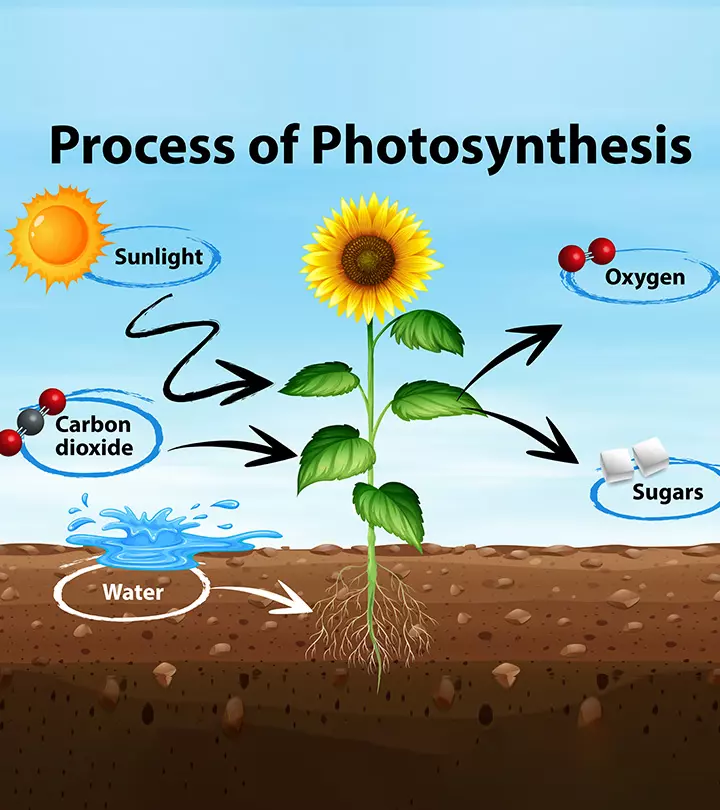
image: iStock
You may enlighten your children with interesting information about static electricity for kids, beginning at home. For example, have you ever tried to raise your hair without touching them? You may do so by rubbing a comb against your hand or clothing and placing it near your hair; you see your hair standing up instantly. The science behind this action is referred to as static electricity. Other instances of static electricity in your daily lives are feeling a current sensation when you accidentally touch a doorknob while walking on a carpet or detecting little sparks when you remove towels from the dryer. Read on as we discuss all the details you might want to know about the hair-raising phenomenon and some fun facts about static electricity for kids.
Key Pointers
- When two surfaces collide or interact, a static charge is generated, with one surface being positively charged and the other being negatively charged.
- Printers, photocopiers, and electrostatic air filters employ static electricity.
- On a dry, low-humid day, static electricity builds up faster, like causing your hair to stand straight and away from each other when combed in the winter.
What Is Static Electricity?
Static electricity refers to the accumulation or build-up of electric charge on the surface of an object. It is called static because the electric charge remains constant and does not flow or move.
You might have learned in your physics class that every existing thing is made up of atoms, and these atoms are made up of neutrons, protons, and electrons. Neutrons and protons make up the nucleus, the center of the atom, while the electrons move around the nucleus. Protons have a positive charge, neutrons are neutral, and electrons have a negative charge.
A static charge is generated when two surfaces come in contact, and the electrons get transferred from one surface to another. In the process, one surface becomes positively charged, and the other surface becomes negatively charged.
Similar charges always show electrostatic repulsion, and opposite charges always show electrostatic attraction. Thus, your hair standing upright and away from each other when they are combed in winter is an example of the presence of static electricity on every hair strand.
You can try out the following experiment to understand how the phenomenon of static electricity works.

- Rub two objects, such as a balloon and a cloth. The electrons of the balloon get energized and gather on its surface.
- As this charge is steady on the surface, it is called static.
- Now, press this balloon against a wall, and notice how it gets stuck to the wall.
- This happens because a surplus of electrons (negative charges) is added to the balloon’s surface, and now the wall is a more positively charged object than the balloon.
- As opposite charges attract, the balloon sticks to the wall (1) (2) (3).
Uses Of Static Electricity
Let’s learn about the uses of static electricity in our day-to-day life (4) (5) (6) (7) (8).
1. Photocopiers: Static energy is used in photocopiers to attract the ink powder, known as toner, to the paper. A copier has a special drum that is charged with static energy. This drum attracts the negatively charged toner particles onto paper, forming precise letters or figures. Thus, static electricity helps you print your favorite cartoons or complete your craft assignments.

2. Paint sprayers: In this case, the object to be painted is given a static charge. When sprayed, this static charge attracts the paint.
3. Electrostatic air filters: Electrostatic air filters have rods that are given a static charge. These rods attract neutral particles from the air.
Although static electricity is generally safe, it can be harmful in a few cases.
1. In airplanes: Airplanes are fueled by refueling trucks. If an electrostatic charge builds up in the refueling pipe, it might cause a spark.
2. Lightning: Have you ever heard about lightning striking people, animals, or trees? Lightning is static electricity built up inside a storm cloud. There are countless water droplets and ice crystals in these storm clouds. The bottom portion of a storm cloud is negatively charged, while the top part is positively charged.
When the negative charge gets strong enough, we witness lightning strikes. This sudden discharge of static electricity may be dangerous, so if you are out in the open, immediately move inside the house to stay safe.
3. Computers: Are you interested in computer hardware? The electronic chips inside a computer are highly sensitive to static electricity. You have to ground yourself before handling computer boards that have electronic chips mounted on them. This can easily be done by wearing rubber slippers. Use a wooden tabletop to place the components, and do not wear woolen or synthetic clothes, as these are good at gathering static charges.

Cool Facts About Static Electricity
Here are some interesting facts about static electricity (1) (9) (10).
1. Researchers at the University of Buffalo suggest that static electricity could be harnessed to charge our electronics in the near future.
2. A spark of static electricity can measure thousands of volts but has very little current and lasts for a short time.
3. A bolt of lightning can carry a voltage of more than 10 million volts.

4. Static electricity can build up faster on a dry and low-humid day.
5. Even though lightning is dangerous, about 70% of people who are struck by lightning survive.
6. A spark of static electricity can measure up to 3,000 volts.
7. Static cling, the problem you face with clothing that clings to your body due to static electricity, can be solved by applying lotion to your skin.
8. Our skin protects our body from electricity, but certain voltages that are too strong for our skin to endure can lead to shocks. Wet skin conducts electricity more easily than dry skin.
9. In the US, the highest number of deaths due to lightning occur in Texas and Florida, but the highest incidence of lightning incidents occurs in Arizona, Arkansas, Mississippi, and New Mexico.
Frequently Asked Questions
1. What is the best material to create static electricity?
Wool, nylon, and silk are some materials that might create static electricity. These materials are likely to develop heavy friction in a dry environment when they come in contact with different materials resulting in high static electricity.
Kay Stephen, a school teacher, describes how she helps her students determine which materials would produce the most static electricity on a balloon. She writes, “I began the class by modeling how a balloon holding static charge can be used to pick up pieces of confetti (the holes collected out of my hole-puncher). We drew on our previous knowledge, from last week’s classes, to determine how the balloon could be charged with static electricity. I told the students that we were going to do an investigation to determine what material would produce the greatest static charge on the balloon…
“The students designed an observation table by drawing a simple t-chart. On the left side they wrote ‘type of material’ and on the right side they wrote ‘number of pieces of confetti collected.’ Working in pairs they performed the investigation and were incredibly intrigued by it. It made me realize how much of the sense of wonder grade nine students still have in them… After testing a variety of materials, such as wool, silk, hair, fur and plastic the students were able to analyze their data to determine which materials created the most static and which created the least (i).”
2. What are the main causes of static electricity?
Materials with low electrical conductivity and high resistance to the flow of electric current may cause static electricity. Examples of such materials include rubber, glass, and plastic.
3. How is static electricity different from current electricity?
Static electricity is the electricity built up on an object’s surface without electron flow. A classic example of static electricity is lightning in the sky. In contrast, current electricity is generated by the flow of electrons. Current electricity can be seen in running fans, light, TV and other electrical equipment.
Early physics lessons help children develop an interest in the subject. Your children may see many examples of physical phenomena, such as static electricity, in their daily lives. However, talking to them about these instances can intrigue them and encourage them to learn more. Further, indulging them in interesting science experiments for kids at home can help them understand concepts clearly at the grassroots level. Hence, if your child is fascinated by static electricity, introduce them to these science facts for kids to help them easily understand this interesting phenomenon.
Infographic: How To Get Rid Of Static Electricity In Your Home
Static electricity has several practical applications. However, there can be instances where it may spiral out of control, making it less appreciated. So while you try the static electricity experiments shared above, use this infographic to acquaint your child with its risks and ways to get rid of static electricity at home. Illustration: Momjunction Design Team
Illustration: Static Electricity For Kids: What It Is Facts And Uses

Image: Stable Diffusion/MomJunction Design Team
Check out this awesome video to learn 5 fun static electricity experiments for kids! Join the exciting adventure of learning about the power of static electricity with your curious young ones!
Personal Experience: Source
MomJunction articles include first-hand experiences to provide you with better insights through real-life narratives. Here are the sources of personal accounts referenced in this article.
i. Static electricity – creating an electrostatic series — posting five; BlogspotReferences
1. Static Electricity; International Association of Certified Home Inspectors
2. Static Electricity Experiments;University of Wisconsin -Madison
3. How does static electricity work?; Library of Congress
4. Static Electricity in Everyday Life;Hayward’s Science
5. How Does a Photocopier Work?; Midshire
6. Refuelling and Defuelling Risks;SKYbrary
7. How Is Lightning Made?;NASA
8. Francis Martinez; Explosive Safety with Regards to Electrostatic Discharge;University of New Mexico
9. Static electricity could charge our electronics;University of Buffalo
10. Jacob D. Jensen, Jeff Thurman, and Andrew L. Vincent;Lightning Injuries;StatPearls
Community Experiences
Join the conversation and become a part of our nurturing community! Share your stories, experiences, and insights to connect with fellow parents.
Read full bio of Beth Sullivan
Read full bio of Sravani Rebbapragada
Read full bio of Harshita Makvana
Read full bio of Praggya Joshi



















